THEME: PEOPLE
 Chen Shijun's distinctive painting style mediates between digital and physical images. The Online Encyclopedia series, for example, takes prosaic images found while browsing online as its source material, and then interprets it through through heavy texturing and a nostalgic palette, converting the raw digital image into a final product with an exceptional sense of physicality. Online Encyclopedia: True Facts No. 2 takes as its source a digital photograph of man's 1960s landing on the moon. The photograph bears the watermark of Xinhua, the official news agency of the Chinese government. Chen Shijun highlights the conflict between battling narratives from the United States, responsible for the landing, and Xinhua, responsible for narrating the story to a Chinese audience. The title of the work, True Facts (2) is a question asking what is reality, how is it represented, and who tells it?
Chen Shijun's distinctive painting style mediates between digital and physical images. The Online Encyclopedia series, for example, takes prosaic images found while browsing online as its source material, and then interprets it through through heavy texturing and a nostalgic palette, converting the raw digital image into a final product with an exceptional sense of physicality. Online Encyclopedia: True Facts No. 2 takes as its source a digital photograph of man's 1960s landing on the moon. The photograph bears the watermark of Xinhua, the official news agency of the Chinese government. Chen Shijun highlights the conflict between battling narratives from the United States, responsible for the landing, and Xinhua, responsible for narrating the story to a Chinese audience. The title of the work, True Facts (2) is a question asking what is reality, how is it represented, and who tells it?
Click on the artwork for more information-
$35.00
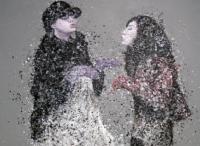 Huang Yuncan’s series New Youth, looks at the transience of youth and the delicate memories it creates. Huang mimics the haziness of recollection with floating spots that coalesce into figures and interactions.
Huang Yuncan’s series New Youth, looks at the transience of youth and the delicate memories it creates. Huang mimics the haziness of recollection with floating spots that coalesce into figures and interactions.
Two women with puckered lips approach one another with awkwardly bent knees and wrists. Their affected air kissing belies a system of social interaction borrowed from elsewhere—are these kisses of greeting, parting, or have they taken on a completely new meaning? In contrast with their parents generation, these members of China’s urban youth sport the latest fashions, Chuck Taylors and sunglasses. With the exception of the women’s flushed faces, the only other items that receive special notice are the purple gloves and red coat, bringing focus to material possessions. Within the mind’s unreliable archives, a superficial detail can come to define a moment.
This moment seems contemporary, but Huang presents it as a memory, begging the question of what the future holds for this generation and its hybrid culture, and more importantly, what it will be remembered for.
Click on the artwork for more information-
$35.00
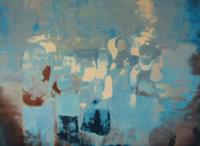 The youthful figures from Exponential Repetitions of Visual Readings: Play by Wang Chunli, are nostalgic and almost ghost-like, their forms barely fleshed out in a palette of blue, brown, and beige. Wang Chunli's painting technique is heavily mediated by the act of facsimile, making physical and digital copies of images until they are reduced to their essence. His painting style evokes the quality of memory; shapes shift and shimmer in an ether tempered by blue melancholy. The subjects are indistinct, as are the specifics of their presence, and it is perhaps the emotional tones of the painting that register most clearly.
The youthful figures from Exponential Repetitions of Visual Readings: Play by Wang Chunli, are nostalgic and almost ghost-like, their forms barely fleshed out in a palette of blue, brown, and beige. Wang Chunli's painting technique is heavily mediated by the act of facsimile, making physical and digital copies of images until they are reduced to their essence. His painting style evokes the quality of memory; shapes shift and shimmer in an ether tempered by blue melancholy. The subjects are indistinct, as are the specifics of their presence, and it is perhaps the emotional tones of the painting that register most clearly.
Click on the artwork for more information-
$35.00
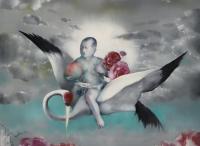 Luo Fahui is part of the generation of artists who studied fine arts shortly after the Cultural Revolution (1966-1976). His oil paintings, which are characterized by surreal, pearly gray compositions, punctuated by bright splashes of crimson and turquoise, address themes of desire, isolation and violence.
Luo Fahui is part of the generation of artists who studied fine arts shortly after the Cultural Revolution (1966-1976). His oil paintings, which are characterized by surreal, pearly gray compositions, punctuated by bright splashes of crimson and turquoise, address themes of desire, isolation and violence.
The title of this work refers to ancient poems of mystical excursion, in which a Daoist master is carried off to the realm of the Immortals. These stories were sometimes fantasies of poets who dreamt of escaping conventional society. In Chinese mythology, the Immortals’ preferred mode of transportation was a fantastical red-crowned crane; mortals who achieved immortality were similarly carried off by one of these creatures. The Immortals prized rare magical peaches, which conferred 1000 years of life on those who consumed them.
In Mystical Journey, the artist has added a slew of roses, which in Luo’s work are frequently associated with desire and lust. The Daoist master has been replaced with a large fleshy boy, possibly the artist’s alter-ego. The crane hovers indecisively between an inviting bed of lush blossoms below and the glowing heavens above. The child bears a peach of immortality in one arm and more roses in the other. It appears that some difficult choices will have to be made if the journey to transcendence is to be completed.
Click on the artwork for more information-
$35.00
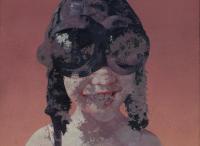 A toothy grin and great googly eyes. A child smiles at you, and the aviator's cap on her head is both absurd and whimsical, a joke the child knowingly shares with you the observer. Children are a frequent theme in Guo Jin's work, meditations upon pure joy and unadultered idealism. But against the context of modern China, the commentary takes on deeper, critical tones, asking if society's innocence has been lost or if naivety remains; if our worldview is youthful with its eyes full of opportunity, or blinded and obscurded by play-acting and make-believe.
A toothy grin and great googly eyes. A child smiles at you, and the aviator's cap on her head is both absurd and whimsical, a joke the child knowingly shares with you the observer. Children are a frequent theme in Guo Jin's work, meditations upon pure joy and unadultered idealism. But against the context of modern China, the commentary takes on deeper, critical tones, asking if society's innocence has been lost or if naivety remains; if our worldview is youthful with its eyes full of opportunity, or blinded and obscurded by play-acting and make-believe.
Click on the artwork for more information-
$35.00
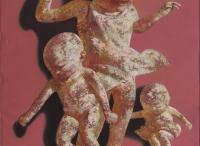 Children are a frequent theme in Guo Jin's work, meditations upon pure joy and unadultered idealism. Jumping catches three children at Henri Cartier-Bresson's “decisive moment,” poised in kinetic potential as they jump mid-air against an abstract pink sky. Their rounded bodies possess a convincing heft, but their skin is spackled in red, yellow, peach, and white, a texture that suggests both materiality, like the surface of marble, and the passage of time, like antiqued painted furniture. Are these children real or allegorical? Where are they leaping to and what are they leaping from? Guo Jin's work gives itself to many different readings, but the children's sense of dynamism and joy remains constant.
Children are a frequent theme in Guo Jin's work, meditations upon pure joy and unadultered idealism. Jumping catches three children at Henri Cartier-Bresson's “decisive moment,” poised in kinetic potential as they jump mid-air against an abstract pink sky. Their rounded bodies possess a convincing heft, but their skin is spackled in red, yellow, peach, and white, a texture that suggests both materiality, like the surface of marble, and the passage of time, like antiqued painted furniture. Are these children real or allegorical? Where are they leaping to and what are they leaping from? Guo Jin's work gives itself to many different readings, but the children's sense of dynamism and joy remains constant.
Click on the artwork for more information-
$35.00
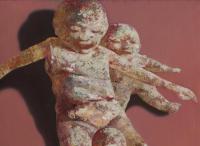 Children are a frequent theme in Guo Jin's work, meditations upon pure joy and unadultered idealism. Sliding captures a group of three moving with grace and abandon down an unseen slide behind them. Their movement is innocent, capturing a moment of play, but when the children are considered as stand-ins for something greater, whether that be society or the state of a country, the painting takes on greater complexities: does the downward slide imply loss or danger, and if so, what is the childrens' agency? Did they initate this descent, or plunge into it unwittingly? Guo Jin's work gives itself to many different readings, but the painting's sense of momentum and unknown potential remains constant.
Children are a frequent theme in Guo Jin's work, meditations upon pure joy and unadultered idealism. Sliding captures a group of three moving with grace and abandon down an unseen slide behind them. Their movement is innocent, capturing a moment of play, but when the children are considered as stand-ins for something greater, whether that be society or the state of a country, the painting takes on greater complexities: does the downward slide imply loss or danger, and if so, what is the childrens' agency? Did they initate this descent, or plunge into it unwittingly? Guo Jin's work gives itself to many different readings, but the painting's sense of momentum and unknown potential remains constant.
Click on the artwork for more information-
$35.00








